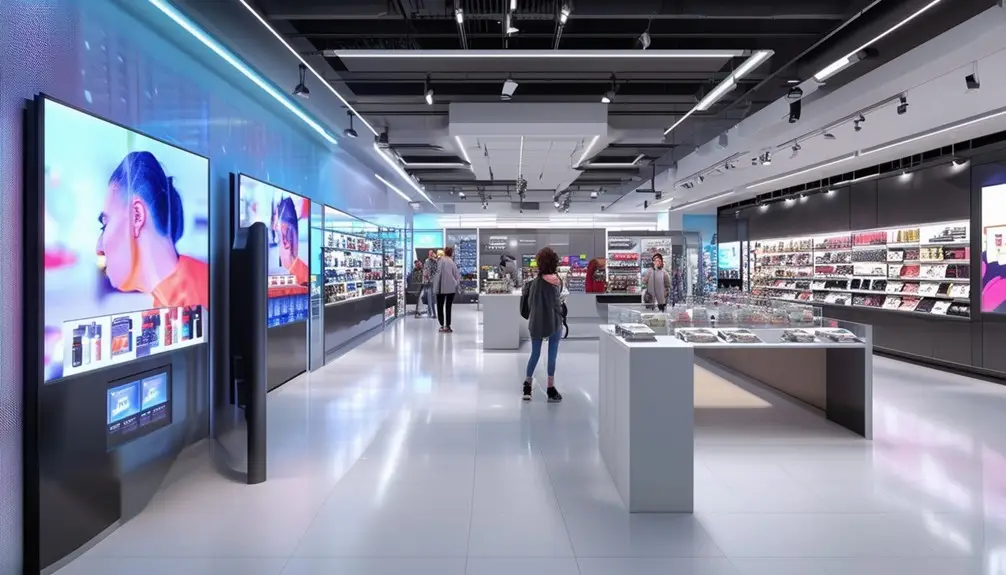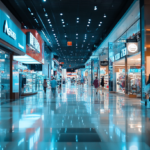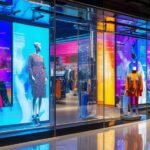Smart retail signage can transform your small business by boosting sales and customer engagement. Use high-grade screens, digital signage players, and robust online content management systems to display dynamic, personalized content. Equip your setup with interactivity through cameras and sensors, and analyze customer behavior using data analytics. Plan clear objectives like increasing foot traffic and enhancing engagement. Choose suitable hardware such as LCD, LED, or OLED screens and affordable media players. Schedule and manage content efficiently with automation tools. Opt for cost-effective solutions to keep within budget. Learn more to make informed decisions and boost your small business.
Key Takeaways
- Boosts Sales: Smart retail signage enhances sales and customer engagement through personalized content.
- Ease of Use: User-friendly interfaces make content management simple for small business owners.
- Cost-Effective Solutions: Digital signage options start at $10/month.
- Data Analytics: Provides insights into customer preferences and trends to tailor marketing strategies.
- Customizable Templates: Offers customizable templates to align with brand identity and attract customers.
Benefits of Smart Retail Signage
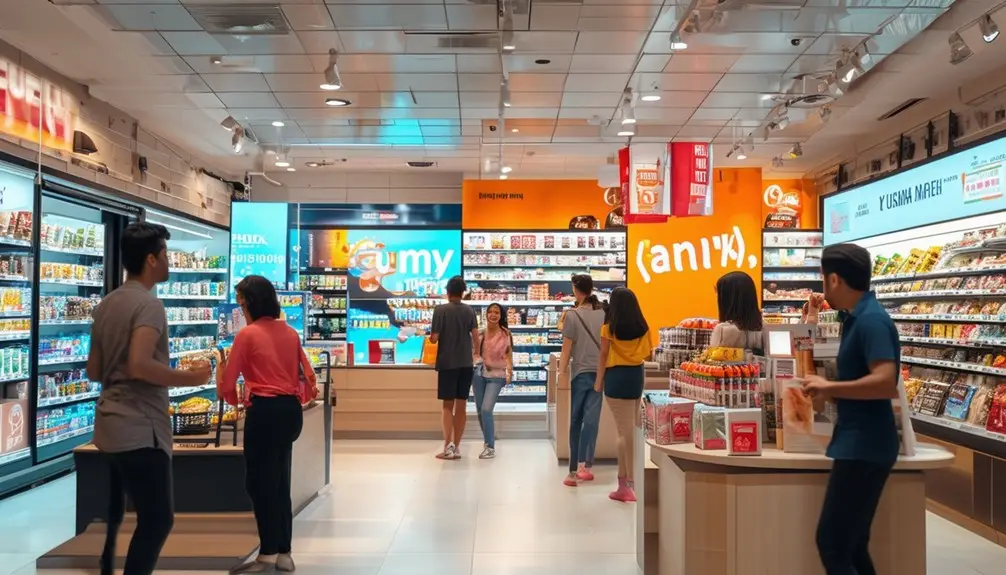
When you integrate smart retail signage into your business, you can greatly boost sales, customer engagement, and brand image. One of the essential benefits is the ease of use. Smart retail signage systems are designed with user-friendly interfaces that allow you to quickly update content without any technical expertise. This means you can effortlessly adjust promotions, inventory updates, and pricing in real-time, ensuring your customers always have the latest information.
Personalized content on smart retail signage can markedly enhance customer engagement and loyalty. By displaying targeted messages and offers based on customer behavior and preferences, you can create a more interactive and personalized shopping experience. This approach not only attracts more customers but also encourages repeat visits.
Additionally, data analytics from smart retail signage provide valuable insights into customer preferences and trends. Leveraging this data can help you optimize your marketing strategies and make informed decisions that drive sales. For small businesses, standing out in a competitive market is vital. Smart retail signage can help you create a modern, tech-savvy brand image that appeals to today’s consumers. By adopting this technology, you position your business as innovative and customer-focused, setting yourself apart from competitors.
Essential Technology for Digital Signage
To implement effective digital signage, you need to invest in core technologies like high-grade screens, reliable media players, and intuitive content management software. High-grade screens guarantee that your content is displayed clearly and attractively, capturing customer attention. Reliable Digital Signage Players are essential for transmitting your content to these screens without interruption. Intuitive content management software lets you easily organize and schedule your content, ensuring timely and relevant messaging.
Internet connectivity is necessary for remote management and real-time updates, allowing you to adjust your signage content on the fly. Adding external devices like cameras or sensors can enhance interactivity and provide valuable data for targeted content. Choosing the right hardware and software setup guarantees your digital signage operates smoothly and effectively.
Key technologies you should consider include:
- High-grade screens: Essential for clear, engaging displays.
- Digital Signage Players: Essential for seamless content transmission.
- Content management software: Simplifies content organization and scheduling.
- Internet connectivity: Enables remote management and real-time updates.
- External devices (cameras/sensors): Enhance interactivity and data collection.
Planning Your Digital Signage Goals
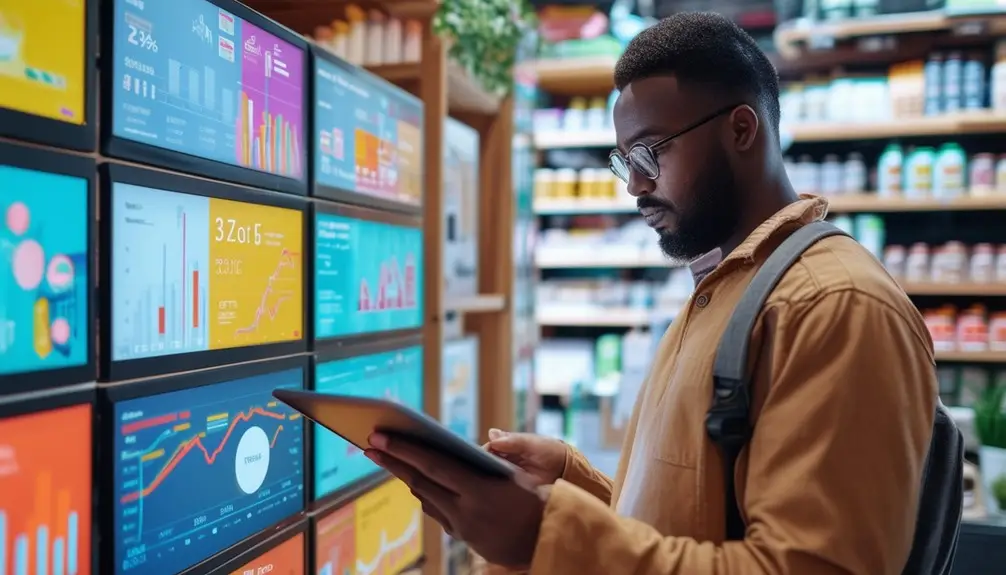
Define your digital signage goals clearly to align with your overall business objectives and resonate with your target audience. Start by identifying specific objectives such as increasing foot traffic, promoting new products, enhancing customer engagement, or improving brand awareness. These goals should be specific and actionable, ensuring they can directly impact your business’s success.
Next, consider the unique needs and preferences of your target audience. Tailor your digital signage content to resonate with potential customers, making it relevant and appealing. This alignment will help in creating messages that attract and engage your audience effectively.
Set measurable goals for your digital signage to track its effectiveness. Metrics like customer interactions, sales uplift, and brand recall are critical. Determine the key performance indicators (KPIs) such as dwell time, conversion rates, or social media engagement to measure success accurately.
Choosing the Right Hardware
When selecting hardware for your smart retail signage, focus on screen types and sizes that fit your space and customer engagement needs. Evaluate media player options and guarantee they offer the connectivity and compatibility required for seamless integration with your existing systems. Prioritize solutions that support remote management to streamline updates and maintenance efficiently.
Screen Types and Sizes
Selecting the right hardware for smart retail signage involves understanding the unique advantages of LCD, LED, and OLED screens, as well as choosing the appropriate screen size to meet your business’s specific needs. Each screen type offers distinct benefits that can enhance your digital signage strategy.
LCD screens are cost-effective and widely used in retail. Their affordability makes them a go-to option for many small businesses. On the other hand, LED displays provide higher brightness levels and are more energy-efficient, making them ideal for both vibrant indoor setups and outdoor installations. If you’re aiming for superior image quality, OLED screens deliver deep blacks and vivid colors, perfect for creating a premium visual experience.
When it comes to screen sizes, the choice should align with your specific use case:
- Small 10-inch screens for product highlights or interactive kiosks.
- Medium-sized displays for point-of-sale or promotional content.
- Large video walls to grab attention in spacious areas.
- Digital menu boards for clear and dynamic customer information.
- Custom sizes to fit unique spaces or branding requirements.
Choosing the right screen type and size is essential for smart retail signage. It helps attract customers, convey your brand message, and enhance the overall shopping experience.
Connectivity and Compatibility
To guarantee your smart retail signage operates seamlessly and integrates effectively with other systems, focus on hardware that offers robust connectivity and compatibility features tailored to your business needs. Choosing the right hardware is essential for ensuring that your content creation efforts yield the best results.
When selecting smart retail signage hardware, consider various connectivity options like Wi-Fi, Bluetooth, Ethernet, HDMI, USB, and NFC. These features ensure that your devices can communicate effectively with other systems and networks, enhancing the overall functionality of your signage.
- Wi-Fi and Ethernet: Secure stable internet connectivity for smooth content updates and remote management.
- Bluetooth and NFC: Facilitate quick and easy interactions with customers, enabling features like contactless payments.
- HDMI and USB: Allow for straightforward integration with media players, sensors, and other external devices.
- Durability: Choose hardware that can withstand the retail environment, securing longevity and minimal maintenance.
- Compatibility: Secure the hardware works seamlessly with your content management systems and other digital tools.
Prioritize hardware that’s easy to install, maintain, and update. This minimizes downtime and secures continuous operation, allowing you to focus on delivering impactful content. Investing in the right hardware will pay off by making your content creation and management processes more efficient and effective.
Designing Engaging Content
To design engaging content for your smart retail signage, focus on high-quality visual elements like sharp images and dynamic videos to capture attention instantly. Incorporate interactive features such as touchscreens or QR codes to enhance customer engagement. Make sure you include clear calls to action to guide customers toward making a purchase or signing up for promotions.
High-Quality Visual Elements
High-quality visual elements like sharp images and captivating videos are essential for capturing and retaining customer attention on smart retail signage. When designing content for digital signage, it’s vital to guarantee your visuals not only attract but also communicate your message effectively. Here’s how you can leverage high-quality visual elements:
- Sharp Images and Videos: Use high-resolution images and videos to maintain clarity and professionalism.
- Concise, Impactful Text: Keep your text brief and to the point to quickly convey your message.
- Branding Elements: Incorporate your logo, brand colors, and fonts to strengthen brand identity and recognition.
- Clear Call to Action: Guide your customers toward a specific action, whether it’s making a purchase or visiting a particular area of the store.
- Consistent Visual Theme: Maintain a uniform look and feel across all visuals to create a cohesive customer experience.
Interactive Content Features
Interactive content features like touchscreens, QR codes, and social media integration can transform your smart retail signage into an engaging customer experience. By incorporating these elements, you can create an immersive environment that captivates your audience and drives interaction. For small business digital signage, utilizing touchscreens allows customers to explore interactive product catalogs, enhancing their shopping experience with real-time product promotions and personalized recommendations.
QR codes offer a seamless way for customers to access additional information, special offers, or even participate in gamified experiences and interactive quizzes. Social media integration provides dynamic content through live feeds, making your signage more relevant and engaging. Integrating dynamic visuals and interactive maps can guide customers through your store, while virtual try-on experiences can significantly impact purchasing decisions.
Implementing advanced interactive features like augmented reality and virtual reality can set your small business apart, creating memorable and unique shopping experiences. Product configurators and self-service kiosks empower customers to personalize their purchases, increasing satisfaction and loyalty. By leveraging these interactive content features in your small business digital signage, you not only enhance customer engagement but also gather valuable data insights to refine your marketing strategies and boost sales.
Clear Call-to-Action
Building on the interactive elements, a clear call-to-action (CTA) in your smart retail signage can drive immediate customer actions and amplify engagement. Effective digital signage content should prompt viewers to take specific actions, like purchasing or visiting your website. To guarantee your CTA stands out, leverage compelling visuals, succinct messaging, and strategic placement.
Incorporating incentives such as limited-time offers or discounts can further encourage customers to act quickly. Here are some key strategies to enhance your CTA:
- Use strong, action-oriented language: Words like ‘Buy Now’ or ‘Visit Today’ convey urgency.
- Incorporate eye-catching visuals: Bright colors and dynamic graphics can draw attention to your CTA.
- Keep messaging concise: Short, clear instructions are easier for customers to understand and follow.
- Position your CTA strategically: Place it where customers are most likely to see it, such as at eye level.
- Test and analyze performance: Experiment with different CTAs and monitor metrics to optimize effectiveness.
Scheduling and Display Management
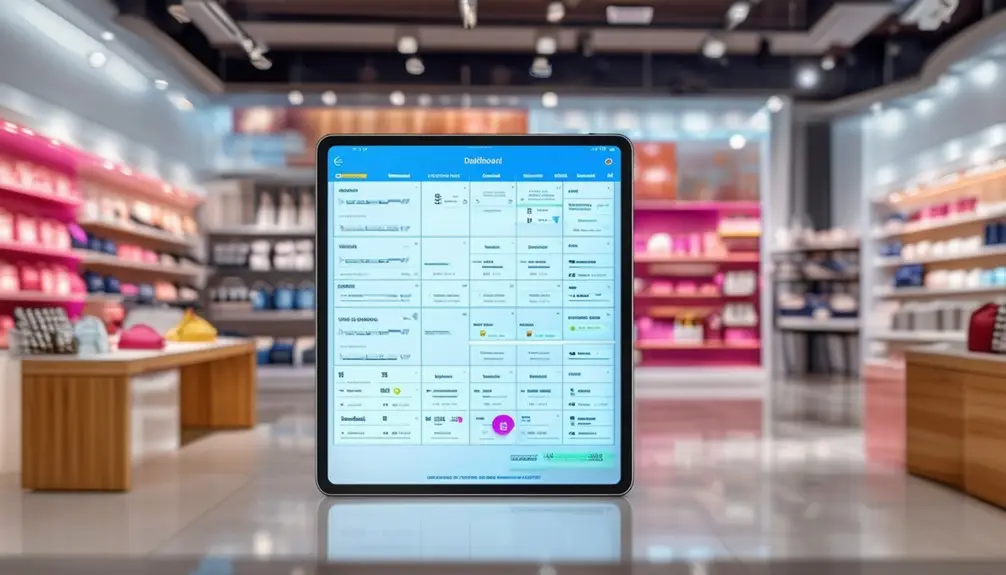
Leveraging scheduling and display management tools in smart retail signage allows businesses to automate content updates and customize their in-store messaging to align with customer flow and peak hours. By utilizing scheduling software, you can plan and automate content changes for different times of the day. This means your screens can dynamically switch from showcasing morning promotions to lunchtime deals, all without manual intervention.
Display management tools provide you with the capability to control what content appears on each screen in real-time. This real-time control guarantees that your promotions, advertisements, and product information are always pertinent and captivating for your customers. When traffic patterns shift, these tools enable you to adapt quickly, maximizing customer engagement and boosting in-store sales.
Monitoring Performance and Analytics
To guarantee your digital signage strategies are efficient, it’s crucial to monitor performance metrics like viewer engagement, content effectiveness, and screen uptime. Utilizing analytics enables you to track customer behavior, conversion rates, and ROI, allowing for data-driven decisions that can substantially impact your small business.
With analytics, you can measure foot traffic, dwell time, and interactions with interactive displays, providing a thorough understanding of how your digital signage is influencing customer behavior. Analyzing this data helps tailor content and promotions to better match customer demographics, preferences, and purchasing patterns, leading to a more personalized retail experience.
Consider these key performance areas:
- Viewer Engagement: Understand how frequently customers interact with your signage.
- Content Effectiveness: Gauge which kinds of content resonate most with your audience.
- Screen Uptime: Ensure your screens are operational and displaying content as scheduled.
- Foot Traffic: Measure how many customers pass by or stop at your signage.
- Dwell Time: Track how long customers engage with your displays.
Real-time analytics enable you to make on-the-fly adjustments to content, scheduling, and promotions based on immediate insights, ensuring your smart retail signage remains relevant and impactful. By continuously monitoring these metrics, you can refine your strategies for maximum efficiency.
Managing Digital Signage Content
Effective digital signage content management requires leveraging user-friendly tools and customizable templates to create dynamic, timely, and captivating displays. Using drag-and-drop editors, you can seamlessly incorporate text, images, videos, and live data into your digital signage. This flexibility ensures your content remains relevant and engaging for your audience.
Tailored templates, designed by professional creators, simplify the creation and deployment process. These templates allow you to maintain a polished and consistent brand image across all your digital displays. Scheduling tools further enhance your content management by automating the display of specific messages at ideal times. This automation ensures that your customers receive the right information when it matters most.
Flexible playback options cater to various hardware and operating systems. This versatility means you can deploy your digital signage without worrying about compatibility issues. Additionally, support teams are available to assist you with live assistance, toll-free support, email, and live chat options. For those who prefer self-service, comprehensive knowledge bases provide step-by-step guides and troubleshooting tips.
Cost-Effective Signage Solutions
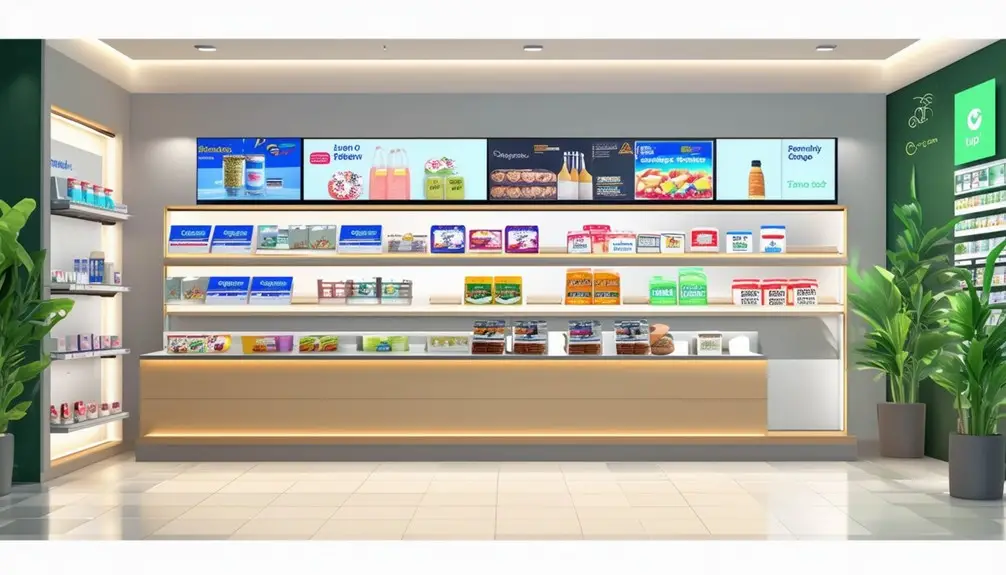
Managing digital signage content efficiently is just one piece of the puzzle; finding cost-effective solutions like Zoney can greatly streamline your operations and reduce overhead. Zoney offers digital signage starting at $10/month per screen, providing a budget-friendly option. Catering to various industries, serving 54% small businesses and 39% mid-market businesses.
Zoney focuses on prompt response times and user-friendliness, which is ideal for small businesses looking for effective solutions. By utilizing their customizable templates, you can create captivating and targeted content without the need for a graphic designer. This not only saves time but also reduces expenses.
Consider these benefits:
- Cost-effective monthly rates: Starting at $10/month.
- Tailored templates: Customize your signage to align with your brand and audience.
- User-friendly interfaces: Simplified interfaces make content management easy.
- Prompt response times: Swift support guarantees minimal downtime and seamless operations.
Conclusion
By embracing smart retail signage, you’ll join the 60% of businesses that report increased customer engagement. With the right technology, engaging content, and strategic planning, your digital signage can transform your store’s experience. Don’t forget to monitor performance analytics to fine-tune your approach continually. Implement these solutions cost-effectively, and you’ll see your investment drive substantial returns, ensuring your small business stays competitive in today’s digital landscape. It’s time to revolutionize your retail space.
Frequently Asked Questions
Is Digital Signage Expensive?
Digital signage isn’t necessarily expensive. With solutions like Zoney at $10/month per screen, you get cost-effective options. Offering user-friendly interfaces, making setup easy and reducing overall expenses.
What Is the Difference Between Kiosks and Digital Signage?
Did you know that interactive kiosks can boost customer engagement by up to 60%? Kiosks offer hands-on experiences through touchscreens, while digital signage passively displays content for advertising and information. Each serves distinct engagement purposes.
Does Digital Signage Increase Sales?
Imagine a local bakery using digital signage to display daily specials; they saw a 30% increase in sales. Yes, digital signage increases sales by attracting customers and influencing their purchasing decisions right at the point of sale.

